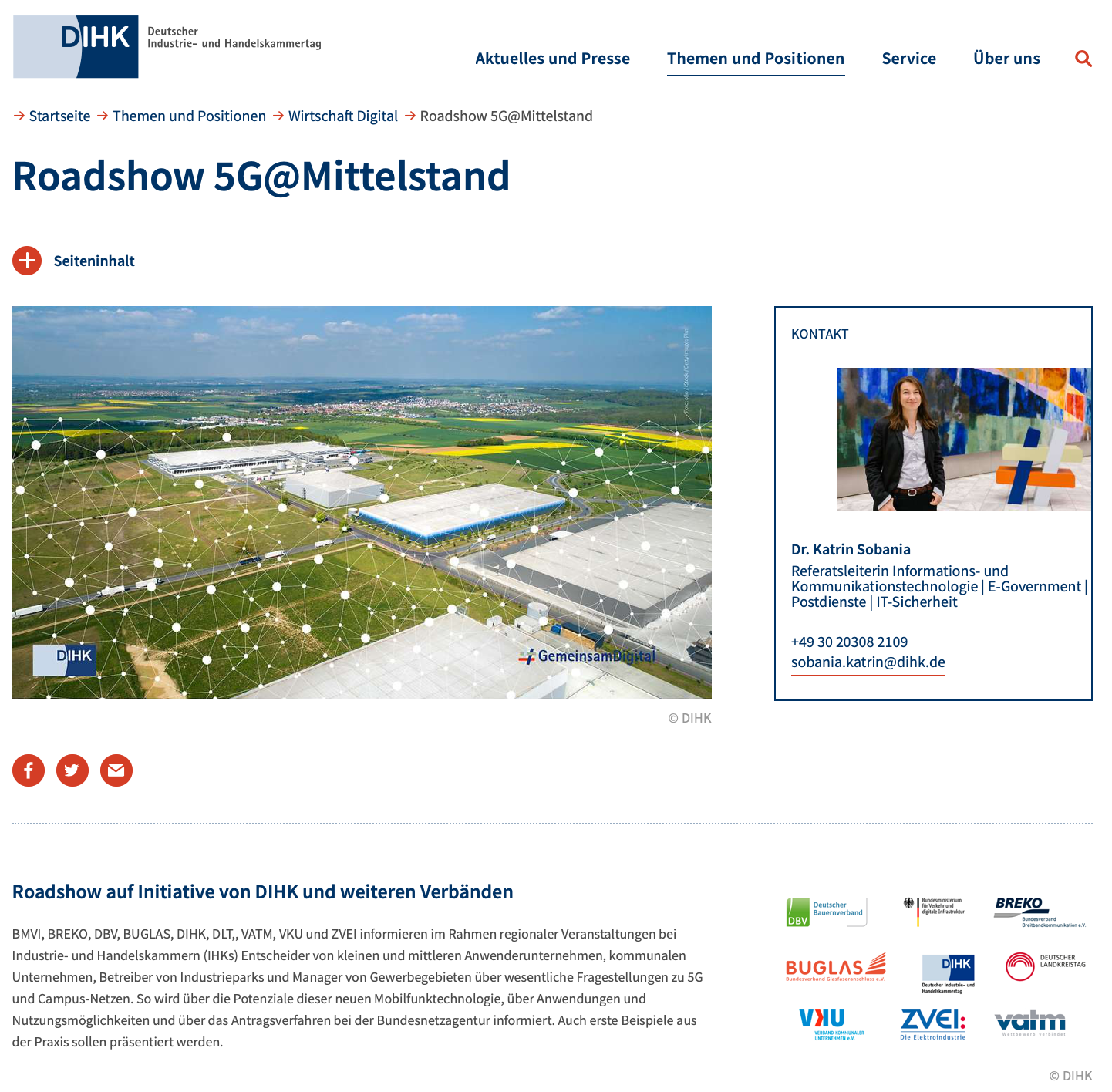Sponsors Article
5G Roadshow via fiber optics
The Association of German Chambers of Industry and Commerce promotes the 5G Roadshow on its website. (Picture: Screenshot dihk.de)
When personal meetings have become difficult or impossible in Corona times, intelligent alternatives have to be found. Webinars are one way of informing your community about important topics in a timely and appealing manner. The German DIHK, however, even organizes a roadshow via fiber optic (or copper cable, depending on …).
Times like these make it very clear: The demand for digital networking in the economy is enormous – and the trend is rising. More and more data is being exchanged digitally, and one of the key technologies for this is the new 5G mobile communications standard. It offers companies the opportunity to set up their own mobile communications infrastructure with so-called 5G campus networks or non-public networks. 5G opens up completely new perspectives not only for large corporations, but also for many small and medium-sized companies.
Together with partners, the DIHK has launched a roadshow to inform companies in the regions about the potential and challenges of the new technology. Since in the current situation around Corona no presence events are possible, those responsible have alternatively created an online offer. The following questions, among others, have already been discussed in an initial five webinars:
- For what kind of applications are campus networks suitable?
- What exactly do I have to do as a farmer, medium-sized machine builder eg. to obtain the licence,
- and who will support me in this?
- How do I set up my own 5G network in a practical way?
- Which partners support me in building and operating the network?
- What costs will I incur?
- The results and presentations of this first webinar series are available on the website www.dihk.de/5g-mittelstand (German).
New digital roadshow
Further webinars will start in September 2020: Among other things, concrete applications will be presented, opportunities for smaller companies to test applications will be introduced, the question of employee acceptance will be examined and expectation management will be discussed.
The first webinars have already identified key points for approaching the topic: First of all, the question should be answered in which application areas in the company the use of 5G is worthwhile
- Does the technology solve a concrete problem?
- Does it increase efficiency?
- Are ideas for new business models available?
Such questions should be investigated by a project team that works closely with the specialist departments. This team should collect suitable usecases, examine different technology options and contact solution providers. Only a company-specific 5G business plan will show whether 5G can sustainably drive digitisation. This should address fundamental questions, such as whether 5G fits into the existing infrastructure, which implementation option fits the needs of the company, for which applications the 5G network is needed or how deep the integration into the control systems should be.
Expectation management is important
In this context, the right expectation management is important: Not all end device functionalities are yet available in the current standard. This should be taken into account in (test) projects. Nevertheless, it makes sense to gather experience and create acceptance in the company even with small projects, even if not all functionalities are available in the end devices in the current standardization phase.
When working with an external implementation partner, one should have a broad market orientation. Before the technical implementation, a fundamental decision should also be made as to whether a proprietary solution is desirable or whether an open solution based on the OpenRAN standard could be interesting and accordingly speak with different providers.
Application to the BNetzA is not an obstacle
The application procedure at the Federal Network Agency represents a rather lower hurdle. The Federal Network Agency (BNetzA) has reserved 100 MHz of frequency bandwidth in the 3.7 to 3.8 GHz range exclusively for campus networks, which can be allocated to eligible applicants in an allocation procedure. These frequencies will therefore not be auctioned off, but a licence fee will be charged for their use. With the application to the BNetzA, a frequency usage concept must be submitted, and land must be tied up in order to avoid competition with publicly available mobile networks. The use-it-or-lose-it principle applies to frequencies allocated by the BNetzA, i.e. if use has not begun within one year and it cannot be credibly demonstrated that concrete plans for use are underway, the frequency allocation can be revoked by the BNetzA. Frequencies are allocated for ten years and can generally be extended without difficulty.
With such and similar questions, the DIHK, together with partners, shows the importance of the topic and wants to reduce uncertainties. In this way, companies in the regions can exploit potential and meet challenges in a relaxed manner.


